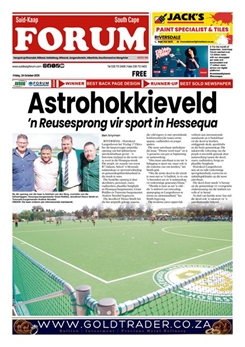SOUTHERN CAPE NEWS - The president of the South African Institution of Civil Engineering (SAICE), Errol Kerst, recently paid a visit to the Southern Cape.
Accompanying him was the CEO, Manglin Pillay.
They were here to support local engineers and to provide insight into recent disasters, such as the prevailing drought gripping the region.
Disaster management
The delegation had an opportunity to engage with Eden Disaster Management head, Gerhard Otto, regarding challenges faced during the various recent disasters in the region over the past 20 or so years.
Otto was well prepared and provided a regional business plan for consideration at national level.
They then met Hessequa Municipality's Harold Basson, to hear how the recent drought in George was managed. He was at George Municipality previously.
Basson gave valuable insight into engaging with the community and local roleplayers. Kerst and Pillay were impressed with the calibre of support available to the region and enjoyed the tour of the Disaster Management facilities at the Eden District Municipality.
There was also an opportunity to engage with the community in a discussion on local radio station, SFM, at their Hartenbos studios, where various matters were discussed for more than an hour.
Desalination plant visit
With the 2009/10 drought conditions still fresh in our minds, a tour of the Mossel Bay desalination plant built in 2010 provides valuable insight.
When the Mossel Bay Municipality and PetroSA realised the area's main water supply, the Wolwedans Dam, was running out of water, engineers, contractors and engineering officials were urgently appointed to alleviate the looming catastrophe.
These professionals worked around the clock to save the region from running dry and the desalination plants were completed in record time.
The Eden District Municipality's Disaster Management team was instrumental in getting the national government to declare the Southern Cape a drought disaster area, which leveraged the support of the Department of Water and Sanitation to draw up emergency plans.
The desalination plant is a high-pressure reverse osmosis plant that removes the salt and separates the brine.
The brine is discharged back into the sea while the clean water is re-mineralised and pumped into the municipal and PetroSA water distribution systems. For now, the plant is idle and maintained on a weekly basis.
The visit highlighted the fact that the plant represented a guideline for the future of such facilities, where numerous municipalities facing the same challenges could learn from and develop their own particular solutions to their present and future needs.
Various lessons can be learned in optimising future designs and this knowledge is invaluable to the whole of South Africa.
Hartenbos
The first project undertaken as part of the drought relief work in Mossel Bay was the Hartenbos Waste Water Treatment Works - a five megalitre per day re-use plant.
Commissioned on 8 July 2010, it was constructed in record time.
In times of need, it takes treated effluent and cleans it to an acceptable level for PetroSA to use.
Almost two-thirds of the expected water demand in Mossel Bay can be supplied through the re-use and desalination plants.
Although the capital, operational, supply and energy costs are high, these is far outweighed by having water security.
This puts Mossel Bay in a strong position for the future, with residents and developers assured of their water supply needs.
Regional weather
The extreme variability in the region's weather plays a major part in the challenges facing local engineers.
For example, the 2006/7 floods were followed in 2009/10 by the worst drought in the history of the Southern Cape - followed by a flood in 2011.
The entire region saw a number of drought relief projects put in to place to address the challenges in the region - all of which have assisted in the handling of the drought.
Similar lessons can be learned from most of the cities and towns in the vicinity.
It is imperative that the correct measures are put in place to identify the challenges early on to allow corrective plans to be put in place.
Lying in wait this year
Kerst and Pillay expressed their excitement at the local SAICE branch's 2018 calendar.
Lined up are school competitions for smart Grade 8 to 12 learners which are planned in early March at the Transnet Railway Museum.
Learners are set challenges in water distribution modelling and in building the strongest and most aesthetic bridges - made out of wooden strips.
Regional winners are sponsored to attend the SAICE national competition which will be held in Gauteng later this year.
In addition to the CPD-registered contractual and project management training the branch hosts in the region, technical talks by experts are arranged to the benefit of its members.
At the prestigious regional excellence awards evening, SAICE recognises and honours the very best water, transportation, environmental, community upliftment, geotechnical and structural projects in the region.
Winners in each category are also entitled to progress to the prestigious national awards.
Another highlight is the planned Water Day, where members of the public can visit, under supervised conditions, various water infrastructure projects (water treatment works, ultra-filtration plants, reservoirs, pump stations, dams, wastewater treatment works) to learn more about the civil infrastructure that has become a part of day-to-day life.
Pillay challenged the local branch to engage with the local press and attempt to prepare a number of educational articles for the community.
"This will go a long way in engaging and empowering the communities we serve regarding the role and responsibilities of the engineering community."
For more information about the SAICE Southern Cape branch, contact Adrian van Molendorff (082 773 3535).
Article courtesy of our sister publication, Mossel Bay Advertiser.
'We bring you the latest Mossel Bay, Garden Route news'

















